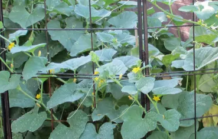Asparagus is one of those vegetables where freshness is incredibly important. If you have never eaten asparagus fresh out of the garden, try it. It may convince you to grow some of your own. For those who have an asparagus patch, the new spears should be appearing soon. The first asparagus that comes through the ground always seems to take a long time to reach harvest size. That is because asparagus growth is temperature dependent. The higher the day and nighttime temperatures, the faster it grows. Also, the longer the spear, the quicker the growth. As the season progresses and spears get longer, the growth rate increases.
Harvest asparagus by snapping or cutting. Snapping is quick and easy. Simply bend the stalk near the base until it breaks. Snapped ends dry quickly so refrigerate or use soon after harvest. If you cut asparagus, use a sharp knife to detach the spears slightly below ground level. This base is woodier than snapped asparagus, so it doesn’t lose water as quickly. Cut off woody ends before cooking.
So, how long can asparagus be harvested? Do not harvest at all the year of planting. The next season, harvest for 3 to 4 weeks or until the spear size drops off. Every year thereafter, the asparagus can be harvested for 6 to 8 weeks. (Ward Upham)
Frost Proof Vegetable Plants
Certain vegetables can withstand cold spring temperatures as long as they have been toughened up by gradually exposing them to sunlight and outdoor temperatures. This “hardening off” process usually takes about a week.
Reducing watering and temperature is the key to toughening up transplants. If possible, move transplants outside for a portion of each day. Start by placing them in a shady, protected location and gradually move them into a more exposed, sunny location as the week progresses. Hardened off cabbage, broccoli, cauliflower and onions can withstand temperatures near 20 F without being killed. Lettuce plants are not quite as tough but will be okay if exposed to temperatures in the mid 20s. Don’t hesitate to put these plants out now if extreme cold is not forecast. (Ward Upham)
Growing Large Onions
Onion types: Onions bulb in response to daylength and are classified as short-day, intermediate-day and long-day plants. Onions classified as short-day are triggered to bulb earlier than intermediate-day plants and intermediate-day plants are triggered to bloom earlier than long-day varieties. Intermediate-day onions are best adapted to Kansas conditions if you are looking for large onions. We can also grow short-day varieties but bulbs will be smaller than if they were grown further south because the plants are still small when they are triggered to bulb.
Varieties: If you wish to grow large onions, choose an intermediate type such as Candy, Red Candy Apple or Super Star.
Sets or plants: Though onions can be grown from seed if started inside, we are too late to raise seed-grown plants this year. Therefore, we must grow them from sets or plants. Sets are most often unnamed and will produce smaller onions. Therefore, don’t use sets if the goal is large onions but rather plants of one of the three varieties mentioned above or of another intermediate-day type.
Fertilizing: Onions have shallow root systems and need good, even moisture and adequate fertilizer to develop large bulbs. Fertilize according to soil test and work the fertilizer into the soil before planting. If a soil test hasn’t been done, use a complete, balanced fertilizer such as a 10-10-10 at the rate of 1 pound per 100 square feet. Actually, any fertilizer with the three numbers being similar will work; just follow the directions on the bag to determine how much to use.
Onions respond well to side-dressing (fertilizing a second time) about 3 weeks after the plants have started to grow. Use a fertilizer composed primarily of nitrogen such as nitrate of soda (16-0-0). This fertilizer may be applied at the rate of 2 pounds (about 4 cups) per 100 feet of row. High nitrogen lawn fertilizers such as a 27-3-3, 30-3-4, 29-5-4 or something similar are also good choices, but the rate should be 1 pound (2 cups) per 100 feet of row. Do not use lawn fertilizers that contain weed killers or weed preventers.
Planting: Space plants 4 inches apart to provide adequate room for bulb expansion. Set plants 1 to 1.5 inches deep. Rows can be spaced 12 to 16 inches apart or whatever is convenient.
Care: Keep the onions weeded to reduce competition. Water once per week if no rain. Onions should be ready for harvest around the first half of July. (Ward Upham)
Division of Horticulture
2021 Throckmorton, KSU
Manhattan, KS 66506
(785) 532-6173




